A flight warning has been issued for April’s much-anticipated solar eclipse due to ‘higher-than-normal traffic volumes expected at airports’.
The Federal Aviation Administration (FAA) released the announcement on Thursday, saying that airports along and near the ‘path of totality’ will likely experience delays and diversions from April 7 to April 10.
Hundreds of airports from Maine to Texas are under the warning, including America’s busiest facility, Dallas-Fort Worth International, which sees more than 200,000 travelers each day.
The announcement comes as state officials fear cellphone service could be disrupted, also due to the influx of visitors — up to 3.7 million people are set to flock to regions set for the ‘Great North American Eclipse’ .
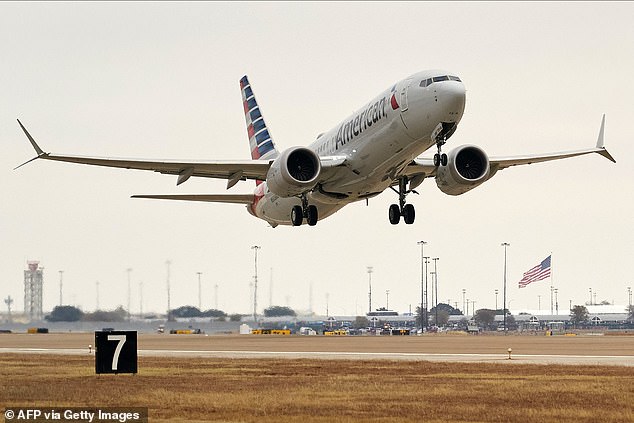
The Federal Aviation Administration (FAA) released the announcement Thursday, saying airports along the ‘path of totality’ are likely to experience delays and diversions from April 7 to April 10
“Aircraft should be prepared for potential airborne holding, diversion and/or expect departure clearance times (EDCTs) that may be issued for all domestic IFR arrivals and departures. Traffic Management Initiatives (TMIs) are possible,’ says the FAA announcement.
The National Air Traffic Controllers Association reported that air traffic during the 2017 solar eclipse in the US saw an increase at airports within range of the path of totality – with St Joseph in Missouri experiencing a record 200 percent increase.
Several airports were forced to issue ground stops due to other locations experiencing high traffic.
Evansville Regional Airport representative Justin Hobgood said in 2017: ‘I came in at 9 to find the airspace completely filled with aircraft.
‘I thought the filters weren’t working.’
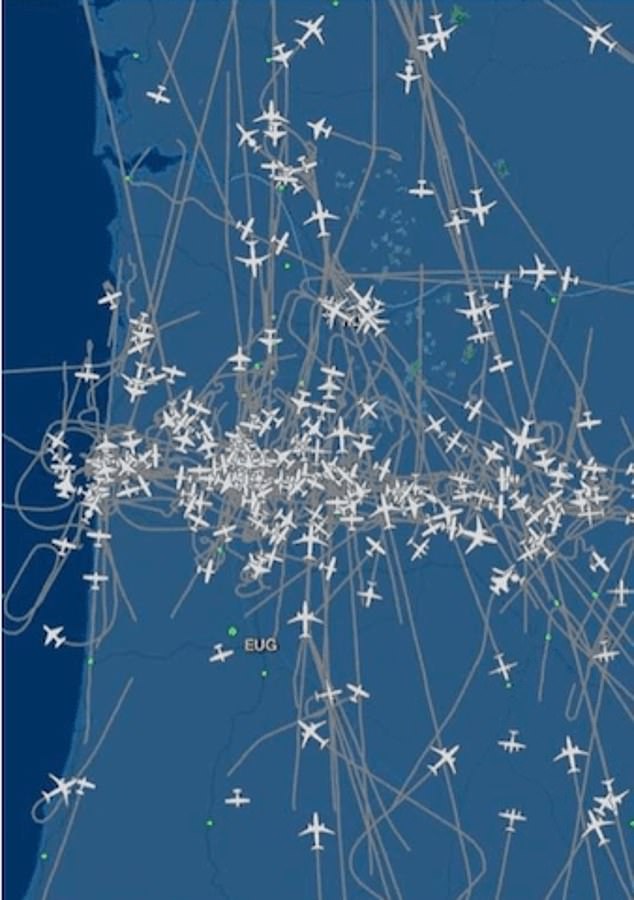

An Oregon air traffic controller said the surge in traffic during the 2017 eclipse was incredible and made for a crazy day — pictures of planes show hundreds of planes traveling in the sky at once
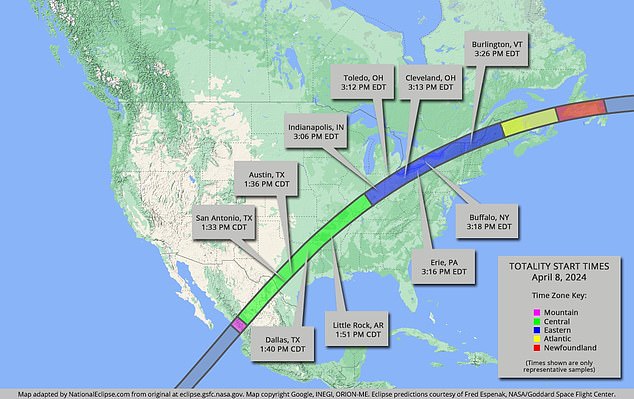

Hundreds of airports from Maine to Texas are under the warning, including America’s busiest facility Dallas-Fort Worth International, which sees more than 200,000 travelers each day
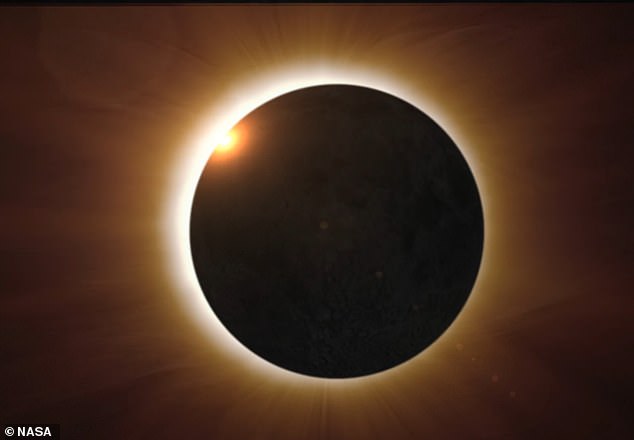

The total sun occurs when the moon completely blocks the sun’s face, briefly darkening the outdoors during the daytime
An air traffic controller in Oregon said the surge in traffic was incredible and made for a crazy day – pictures of planes show hundreds of planes traveling in the sky at once.
And such problems may strike again next month.
The FAA has warned pilots flying in and out of popular airports to prepare for operational changes at any given time.
These airports include Burlington International Airport, Syracuse Hancock International Airport, Indianapolis International Airport, Fort Wayne Airport, Cleveland Hopkins International Airport, Buffalo Niagara International Airport, and Austin-Bergstrom International Airport.
Delta Airlines has also recognized the higher than usual volume and has offered two flights to take tourists close to the path of totality.
The first flight sold out in less than 24 hours, but the company has added a second one out of Dallas-Fort Worth on April 8.
“Delta flight 1010 will depart DFW at 12:30pm CT and arrive in Detroit along with the other route-of-totality flight (DL 1218 from AUS to DTW) at 4:20pm ET,” the company shared on its website .
Delta also advises travelers to board the flight with protective solar eclipse glasses.
Delta Air Lines chief meteorologist Warren Weston said: ‘The April 8 eclipse is the last total eclipse we will see over North America until 2044.
‘This eclipse will last more than twice as long as the one that took place in 2017, and the path is almost twice as wide.’
As airports prepare for an influx of travelers, states are bracing for a boom in tourists that could strain local cellular networks, causing connection delays and dropped calls.
To ease the burden on many US cities, T-Mobile is deploying additional cellular sites that will be on standby in areas that expect high tourist traffic.
In a small Ohio town that could see 250,000 visitors, Verizon is setting up a portable tower ahead of the cosmic event.
Rebecca Owens, director of the Richland County Emergency Management Authority (EMA), told the Richland Source: ‘The cell phone (reception) will be very, very brief.
‘There will be a lot of issues with connectivity and things like that.’
A spokesperson for T-Mobile told DailyMail.com: ‘T-Mobile’s network is ready for the blackout. Our emergency teams are working with state and local officials across the country to provide additional support where needed for large gatherings.’
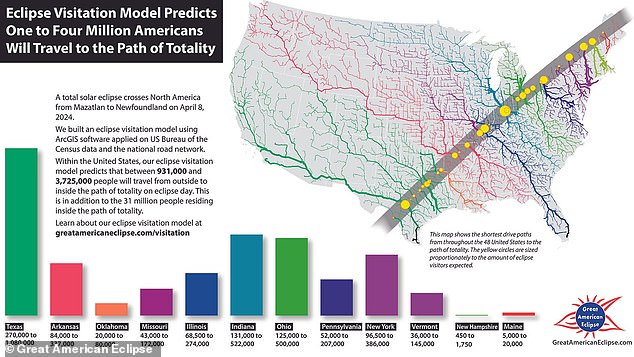

Up to one million are set for Texas, 500,000 in Indiana and Ohio and nearly 400,000 people could travel to New York – and US network providers fear the increased demand could trigger connection delays or dropped calls
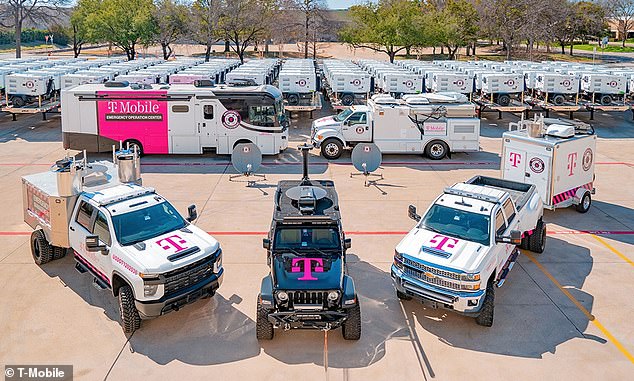

To ease the burden on U.S. cities, T-Mobile is deploying additional cellular sites that will be on standby in areas that expect high tourist traffic
Total solar occurs when the moon completely blocks the sun’s face, briefly darkening the outdoors during the day.
The spectacle will be visible to an estimated 32 million people along a narrow path through North and Central America.
It will mark the first total solar eclipse visible anywhere in the world since December 2021, and the first seen from the United States since August 2017.
Regardless of your location along the path of totality, the total eclipse should be visible for about four minutes.
The solar eclipse itself won’t disrupt cell service, though — the amount of people in the areas is what state officials are concerned about.
AT&T analyzed network traffic during the 2017 eclipse in the United States and found a more than double increase in SMS activity during the 24 hours of the eclipse path of totality compared to the previous Monday.
Data showed a 40 percent increase in text messages and a 15 percent jump in voice calls within those 24 hours.
Ulf Ewaldsson, president of technology at T-Mobile, said: “T-Mobile is working hand-in-hand with state and local authorities to address the expected increase in network traffic to guarantee seamless connectivity for everyone.”
Arkansas is along the path of totality, with state officials preparing for the tourism boom that could see its current population of three million double in size.
Rep. Davis Whitaker, of Fayetteville, said during a legislative session in December: ‘I am concerned about cellular communications.
‘Are the mobile operators in the state part of this plan?’
Arkansas Division of Emergency Management Director AJ Gary told council members that cell connectivity will be one of the biggest challenges during the eclipse, local 40/29 News reported
“Cellular companies are involved in communication. We can also bring in additional cell-on-wheels to increase that capacity,’ said Gary.
Up north in Maine, Franklin County is also having discussions to prepare for limited or even no smartphone service where tens of thousands of visitors are expected, worrying that “cell coverage is scarce as it is.”
Franklin County Emergency Services Coordinator Rob Demarse told the Adirondack Daily Enterprise that the city is working with the Department of Homeland Security to map out all avenues for cell coverage.
And in Texas, which is set to see more than a million out-of-towners, officials are advising people to enable Wi-Fi calling in case of service outages.
The Lone Star State could also see a significant drop in solar generation.
Hugh Cutcher, a data scientist for solar forecaster Solcast, said: ‘Individual assets will lose up to 16 per cent of their daily radiation.
He also predicted that there will be a total loss of 11.7 percent of the state’s total daily solar generation.
As with any eclipse, it is important not to look directly at the sun with the naked eye while the event is taking place – not even through sunglasses, binoculars or a telescope.
A simple pinhole projector, solar eclipse glasses that can be purchased online, or special solar filters are much safer.
